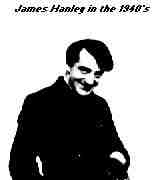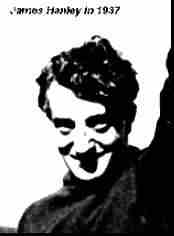James Hanley was born in Dublin in 1901, the second of the 8 children of Edward and Brigid
Hanley. He came from a reasonably well to-do background, although his father had early given
up a promising law career to go to sea "to hang on by his shirt tails to the top-gallant mast, or
whatever the devil they call those queer things they have on ships", as his grandmother later
recalled, and his mother also came from a long line of seafarers. They moved to Liverpool early
in the century, and Hanley followed his father and elder brother to sea as a boy of thirteen.
Sometime later he was to jump ship in New Brunswick and enroll with the Canadian
Expeditionary Force, seeing action in France in the summer of 1918, before being demobilised at
the end of the war. Back in Liverpool he spent another few years at sea before getting a job
as a railway storeman and beginning a career of self-education and writing.
In 1929 he began a
long correspondence and friendship with the writer John Cowper Powys, then living in the United
States, which was to continue until Powys's death in 1963. When he first wrote to Powys he was
almost ready to go back to sea - his short stories were continually returned by the magazines and
the manuscript of his novel Drift had been seen and rejected by 17 publishers. But in late 1929,
while still living with his family in Liverpool, his luck turned, and the philologist Eric Partridge,
then briefly a book publisher, accepted Hanley's Drift for publication in 1930. This was
followed by a powerful story of the First World War The German Prisoner, with an Introduction
by Richard Aldington, and the short novella A Passion Before Death later the same year.
1931 was a busy year for Hanley. Five short stories with a Preface by Powys were published as
Men in Darkness in September 1931, together with the novel Boy, dedicated to Nancy Cunard,
then a young Society heiress, who had apparently given Hanley a typewriter. He also published
the novella The Last Voyage, again with an introduction by Aldington. During the summer of
1931 Hanley married Dorothy (Timothy) Heathcote, and together they went to live in a remote cottage
in North Wales just outside the small town of Corwen.
Hanley's third novel Ebb and Flood was issued in August 1932, followed by Captain Bottell in
1933, dedicated to their son Liam Powys Hanley, born that year, to whom John Cowper Powys
became God-Father. As well as literature, Hanley also had a great passion for music, and struggled
hard, and with some success, to become a pianist.
In June 1934 Powys and his life-long companion Phyllis Playter left the United States to return
to England, settling first near Dorchester amongst the many Powys brothers and sisters living in
the area. But later that year disaster struck both men. Hanley's publishers Boriswood issued a
cheap edition of Boy, with a highly provocative cover of an Egyptian belly-dancer, who actually
played very small part in the story. Police action forced its withdrawal, and Boriswood lost the
subsequent court action and were heavily fined. The book became a cause célèbre and was not
reissued again until 1990. Hanley, who's mother and sister were devout Catholics, was
devastated. At the same time Powys and the British and American publishers of his 1936 novel
A Glastonbury Romance were sued for libel by a Glastonbury businessman. The case was
eventually settled out of court, but the financial cost to Powys was considerable. During this
period Hanley was hard at work on his first major novel, The Furys which was published in
1935. Powys commented : "Well I do congratulate you, Hanley, on this book. It's a great book;
the realism convincing, the characters convincing, the subject tragic in the noblest sense and the
vein of poetical supernatural symbolism frighteningly effective."
The Powys family had a passion for nick-names, and from about this time Powys took to referring
to Hanley as Lord Jim (from the Conrad novel), and his wife as the Lady Tim. In early 1935 the
Hanley's spent a fortnight in Dorchester with Powys, and later that year John and Phyllis travelled
to Corwen to stay in a small cottage near to the Hanley's. Whilst there they looked around and
found a small house of their own, moving there permanently in June 1935.
Over the next few years Hanley published The Secret Journey (1936), the second volume of The
Furys sequence; his entertaining autobiography Broken Water in 1937, and Grey Children, a
major study of the South Wales miners, in 1937, and his gripping novel of the First World War Hollow Sea (1938). In late 1939, at the beginning of the Second
World War, the Hanley's reluctantly decided to leave Wales and return to London, just in time
to experience the worst of the blitz. Despite these distractions Hanley produced Our Time
is Gone, third of The Furys sequence in 1940, two seminal short novels in The Ocean (1941) and
Sailor's Song (1943), and the astounding novel of London during the blitz No Directions (1943),
for which Henry Miller would write an Introduction to the 1946 Uniform Edition.
 After the war the Hanley's were able to return to Wales, and settled in the tiny village of
Llanfechain in the hill country near Welshpool, just across the Berwyn Mountains from Corwen. Over the next few years, Hanley continued to publish outstanding work, to great critical acclaim,
although as usual to only modest sales, most notably The Closed Harbour (1952) and The Welsh
Sonata (1954). A Tribute to John Cowper Powys by Hanley entitled The Man in the Corner was
published in John O'London's Weekly in September 1954, and republished in a special edition of
the Welsh literary magazine Dock Leaves devoted to Powys in Spring 1956. The Hanley's were
now well settled at Llanfechain, and after Levine in 1956 came a fifth and final volume to The
Furys sequence, An End and a Beginning in 1958. Tim Hanley had also begun to write as well as
to illustrate, and in 1953 published her own first novel A Flight of Birds (Macdonald).
After the war the Hanley's were able to return to Wales, and settled in the tiny village of
Llanfechain in the hill country near Welshpool, just across the Berwyn Mountains from Corwen. Over the next few years, Hanley continued to publish outstanding work, to great critical acclaim,
although as usual to only modest sales, most notably The Closed Harbour (1952) and The Welsh
Sonata (1954). A Tribute to John Cowper Powys by Hanley entitled The Man in the Corner was
published in John O'London's Weekly in September 1954, and republished in a special edition of
the Welsh literary magazine Dock Leaves devoted to Powys in Spring 1956. The Hanley's were
now well settled at Llanfechain, and after Levine in 1956 came a fifth and final volume to The
Furys sequence, An End and a Beginning in 1958. Tim Hanley had also begun to write as well as
to illustrate, and in 1953 published her own first novel A Flight of Birds (Macdonald).
The friendship
with Powys continued until his death in June 1963, with occasional visits by the Hanley's, who
continued to write to Phyllis who stayed on in the little house in Blaenau Ffestiniog to which they
had moved until her own death in 1982. The Hanley's reluctantly left Wales in late 1963 to return
to London, and for the next 10 years Hanley concentrated on radio and TV drama, with some notable success, until the early
1970's when with an astonishing creative flurry he produced four major novels: Another World (1972),
A Woman in the Sky (1973), Dream Journey (1976), and The Kingdom (1978).
But he never fully recovered from Tim's sudden and unexpected death in August 1980, although he
continued an active correspondence with a number of friends, particularly his bibliographer Linnea
Gibbs in Canada, and Frank Harrington in the United States, who subsequently published an
excellent short monograph : James Hanley - A Bold and Unique Solitary in 1989, and to whom
he dedicated his last small book Lost in 1979. It was perhaps an appropriate title, for although he
prepared a new collection of stories, published in 1984, he wrote nothing more before his death
in London on 11 November 1985. He is buried in Llanfechain churchyard, amongst the Welsh
hills he loved so much.
 After the war the Hanley's were able to return to Wales, and settled in the tiny village of
Llanfechain in the hill country near Welshpool, just across the Berwyn Mountains from Corwen. Over the next few years, Hanley continued to publish outstanding work, to great critical acclaim,
although as usual to only modest sales, most notably The Closed Harbour (1952) and The Welsh
Sonata (1954). A Tribute to John Cowper Powys by Hanley entitled The Man in the Corner was
published in John O'London's Weekly in September 1954, and republished in a special edition of
the Welsh literary magazine Dock Leaves devoted to Powys in Spring 1956. The Hanley's were
now well settled at Llanfechain, and after Levine in 1956 came a fifth and final volume to The
Furys sequence, An End and a Beginning in 1958. Tim Hanley had also begun to write as well as
to illustrate, and in 1953 published her own first novel A Flight of Birds (Macdonald).
After the war the Hanley's were able to return to Wales, and settled in the tiny village of
Llanfechain in the hill country near Welshpool, just across the Berwyn Mountains from Corwen. Over the next few years, Hanley continued to publish outstanding work, to great critical acclaim,
although as usual to only modest sales, most notably The Closed Harbour (1952) and The Welsh
Sonata (1954). A Tribute to John Cowper Powys by Hanley entitled The Man in the Corner was
published in John O'London's Weekly in September 1954, and republished in a special edition of
the Welsh literary magazine Dock Leaves devoted to Powys in Spring 1956. The Hanley's were
now well settled at Llanfechain, and after Levine in 1956 came a fifth and final volume to The
Furys sequence, An End and a Beginning in 1958. Tim Hanley had also begun to write as well as
to illustrate, and in 1953 published her own first novel A Flight of Birds (Macdonald).
